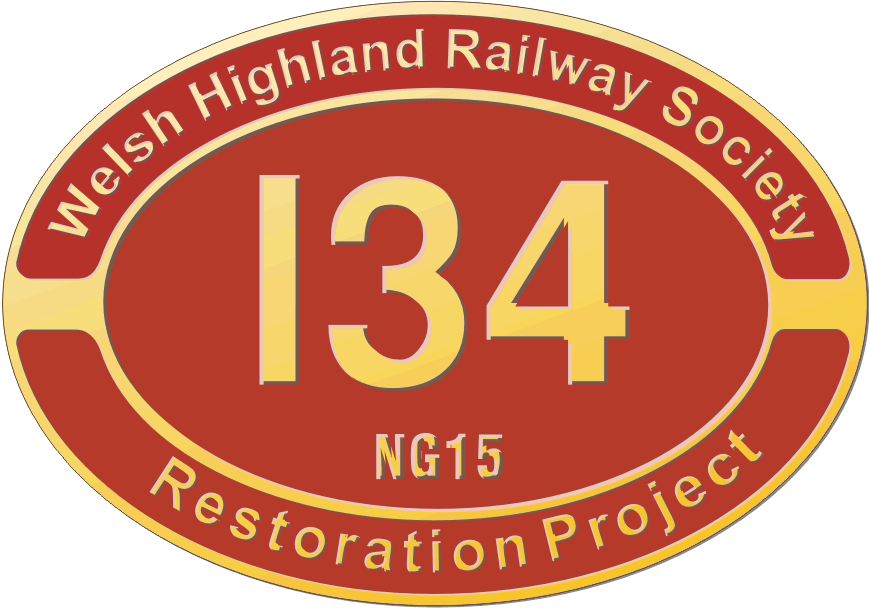
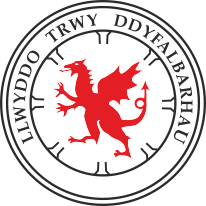 

|
 |
|
| Back to archived working party reports |
December 2010 Report
There was no working party in December other than Andie Shaw paying a visit himself on the weekend of the 11th and 12th. During the visit he checked the welding work done by Brunswick Ironworks where they'd repaired some butchery done in South Africa to the rear coupling of the tender. The rear cross stretcher to the loco frames had also been returned and its fit checked. Due to heat distortion during the repair it will need some plates added and machined to the correct profile where it mates with the frames before final assembly can take place.
The vacuum pan was trial fitted into the tender frames to check for alignment. Some wasted rivets were ground off the rear of the frames in the area of the fire box ready for renewal and finally the jig work for the frame alignment checking was progressed . Some pictures taken during the visit are in the Gallery.
November 2010 Working Party Report
The November Working Party on the 20th and 21st was again well supported with a varied selection of jobs carried out. These ranged from painting to removing bolts and rivets.
The Saturday started by discovering that our friends from Brunswick Iron Works had visited the Loco and had been doing some welding. This consisted of the building up of wastage inside the frames in the area where the rear cross stretcher fits, the welding together of the new running board angles and the repair of the running board supports where some of the South African metal mites had been feeding! These latter repairs and the angles were subsequently painted with primer.
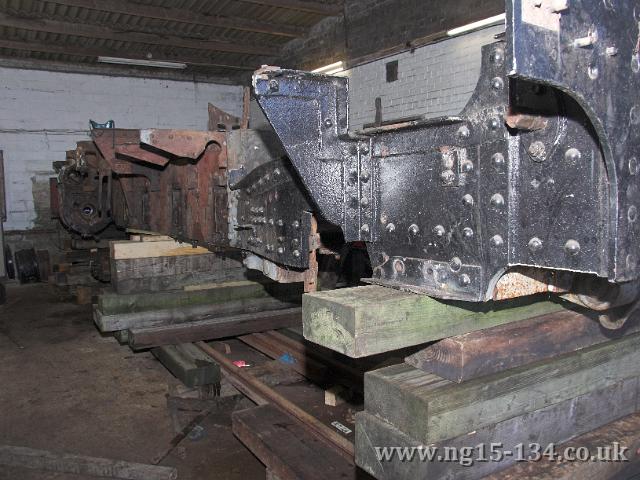 |
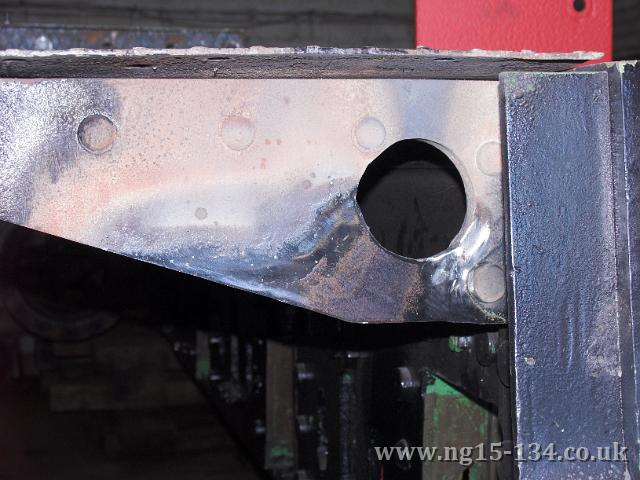 |
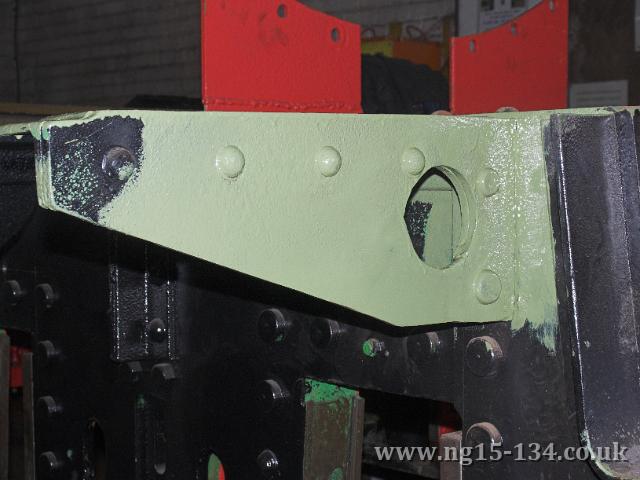 |
The running board support
- as it was in early 2009 (left), after being repaired (middle) and
after priming (right)
Click the picture to go to
the Gallery page for more pictures
The tender's rear drawbar was removed and the South African coupling detached from it. The drawbar was cleaned and as there was still sufficient paint in place it was given a coat of undercoat. A suitable FR chopper coupling was cleaned and primed in preparation for fitting. At some point in the Loco's past the drawbar assembly casting had been replaced in the tender's dragbox. This involved the removal of some sections of the dragbox and the work now compromised the strength needed for the fitment of the new tender body. Templates were therefore made to enable suitable plate material to be cut and welded into place at a later date.
With the running board angles now welded, these and the running boards that had been temporarily fitted were removed so as painting could commence on all these components. The painting was started on the Saturday and completed on Sunday. Another job that started on the Saturday and continued into Sunday was a start being made on the removal of rivets on the front tender drag box.
Sunday's
main jobs consisted of the manufacture of a jig for the alignment of
the cylinders and frames as well as the attachment to the frames of
various alignment brackets. The final job to report was the fitting
of the tender brake arm for the vacuum Pan.
October 2010 Working Party Report
Peter Randall Reports:
The
October Working Party was well
supported with seven volunteers over the two days, as well as the usual
stream of people (always most welcome) who turn up to see what we are
doing. Several small but important jobs were progressed:
All in
all a great weekend (esp as the
Managers beat the Engineers at football!) Photos in the Gallery.
September 2010 Working Party Report
This is the first working party following the Railway's peak summer season and it was satisfying to see it well attended. There is now a good regular group working on the loco and effort wise it enables good progress to be made. Now that's not to say that more hands won't be made use of..... they certainly will!
The group split into two this weekend with one group working on the loco's running boards and the other machining new grease points for the lubrication system.
Brunswick Ironworks delivered some fabricated edging to the running boards as those on the engine were in such a poor condition that it was not worth trying to re use them. The problem encountered however, was that most of the attachment points on the engine were also badly distorted from years of use in South Africa such that quite a bit of straightening work had to be done to get it all to fit!
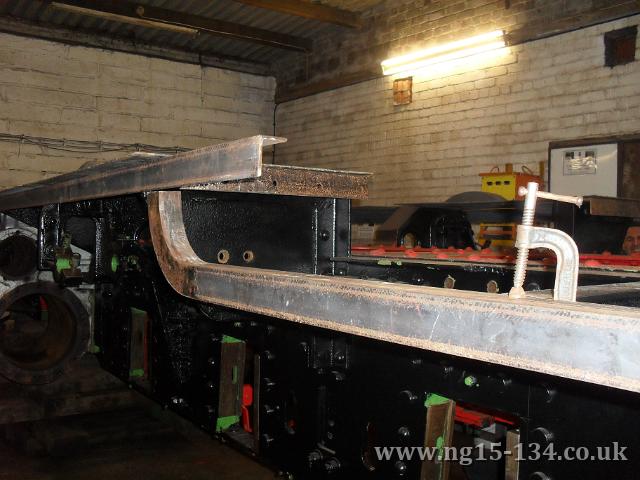 |
The running plate edging
being fitted
Click the picture to go to
the Gallery page for more pictures
As mentioned the second group was attending to the manufacture of some new grease blocks. Normally most of the motion would have either oil or grease lubrication, and whilst the oil lubrication is normally serviced from a central mechanical lubricator, the grease points are not and are individually greased as part of the loco's preparation each morning. This, on a wet Welsh morning, is not the most pleasant of jobs! In order ease this task and to speed up loco prep all the grease points are being brought to a central block so only one point needs to be greased.
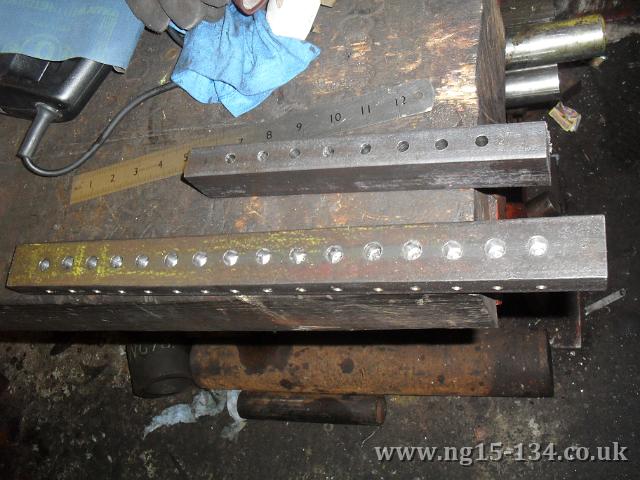 |
New grease block being
manufactured.
Click the picture to go to
the Gallery page for more pictures
July 2010 Working Party Report
With the peak summer season now upon the railway this working party on the 17th & 18th July was the last one until September. The July weekend saw much done however, even if none too obvious.
The main job concentrated on drilling and tapping the frames ready for fitting the jig that will be used to align the horn faces. All the spring and brake gear is now prepared for non-destructive testing and work was started on machining the grease blocks for mounting the grease nipples.
With the wheels now at Boston Lodge for re-profiling (see the News section) there is now a definite feeling that the 'constructive' phase is in full swing. That full swing however, will still be slow work as there are lots of jobs to be done and for this help is always needed. Whilst we welcomed a new face at this working party more pairs of hands are always welcome. See the Contact page for how get in touch to find out how you can help.
Money as always is also going to be a limiting factor to progress and if you've been hovering and perhaps not quite yet got around to helping fund the Loco then please make that final effort to help us financially. It could not be easier now as it can all one done through the Cymdeithas Rheilffordd Eryri Shop. Go to the Online Donations section and everything will only a couple of clicks away. Please help as best you can.
June 2010 Working Party Report
The June working party was held over the weekend of the 19th and 20th. The working parties are now being well attended by volunteers not associated with running the trains therefore good progress is being made during the summer months.
The reverser cress shaft was finally removed from the frames, an aborted task from the previous month. This will allow a more permanent repair do be done to one end where there had been an 'on shed' running repair in South Africa. Another item that was troublesome to work on and that again finally submitted this weekend was the stripping down of the front bogie pivot.
The front brake hanger was refitted after a repair to make it fit correctly! Another completed job is that all the bushes for the spring pillar guides have now been removed.
As well as the teams activities Brunswick Iron Works have been attending to the wastage where the rear frame stretcher fits and have been repairing the running plate supports. In all it was a good weekend's progress. Pictures in the Gallery.
May 2010 Working Party Report
The monthly working weekends are normally held on the third weekend of the Month, however, this May working weekend was held on the second weekend. Now the fact that this coincided with the Welsh Highland Railway's Rail Ale festival might not be purely coincidental!
The weekend work was somewhat varied once again with a number of smaller tasks being tackled. The front running board valance was straightened, cleaned and primed and so this is another piece to join the now refurbished kit of parts. During inspection of the frames it was noticed that there were errors in the mounting of the front brake hanger bracket and so this had to be removed and correctly fitted.
One job started on the Saturday, and that had to be abandoned was the removal on the reverser shaft. The brackets were removed from the frames, however the shaft would not release from one of the bearings, no matter how much heat was applied and how heavy the hammer was! Tired mussels meant this had to be left unfinished. Hopefully it will concede to us at the next working party.
Continued from the last working party was the cleaning and undercoating of some more brake rigging components. Also continued from prevous working parties was the decarbonising of the cylinder valve chests. These are now all very clean looking and should not need doing again for quite some time. Finally a start was made on removing some of the spring guide bushes from the top of the horn guide castings and from the associated bracket above this. These brackets were also removed in some cases. This again was not completed as some were very firmly in place and some of the castings had been previously repaired around the guide hole so there were fears this was not a particularly strong area of the casting.
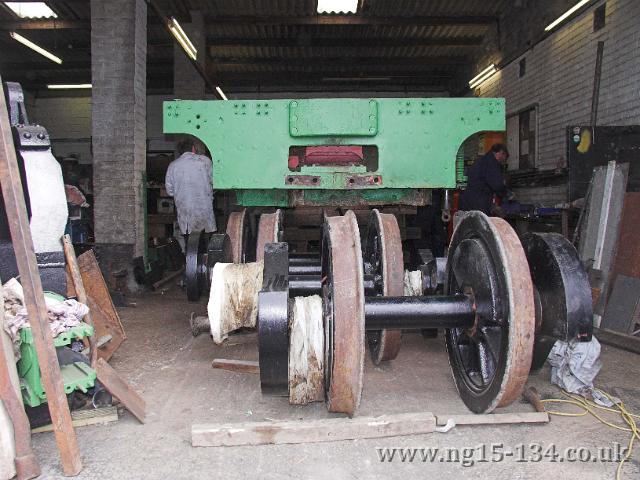 |
April Working Party Report
The April working weekend was held on the 17th & 18th April, a weekend of glorious sunshine. We were very glad to a welcome two new volunteers to the team on the Saturday and whilst one had to return home Saturday evening the second remained with us on Sunday.
The weekend saw a number of jobs tackled of which by far the largest was that of painting. The biggest item for painting was the loco's frames as it wastime to give them their first coat of gloss, it being the intention to gave a second coat later in the project. Saturday morning therefore saw these sanded down in preparation with the actual painting started in the afternoon and completed the following day on Sunday. At the same time as this, your webmaster spend Saturday cleaning up and priming the remaining loco suspension components that as yet had not been touched since their bushes were removed.
Before this however, saturday morning saw two of us going off to look for some missing brake components that were removed during the loco’s initial restoration session some 10 years ago. These were the brake draw-rods and could not be located during the search in previous working party. There was a suspicion they had been put with some point rodding, however, this proved not to be the case and so we are still missing these components.
Saturday also saw some attention being paid to the tender with the removal of some of the metalwork at the front end. This was the removal of some metalwork added 10 years ago when it was thought the tender was going to be set further back on the frames. However now with the new proposed outline it nees removing, as does some of the original metalwork that is life expired.
Sunday, as mentioned saw the loco's frames complete with the first coat of gloss together with yet more painting, this time it being all the wheels receiving an undercoat.
The final job to be mentioned was the continuation of the removal of built up carbon from the right hand valve gear. This involved the use of a certain amount of heat to loosen and dislodge it all.
A short clip from the Working Party on Sunday is available on YouTube:
| Starting with a shot
of №133 this video shows some of the work taking place on №134 on Sunday 18th April 2010 |
March Working Party Report
The March working party took place as expected on the weekend of the 20th & 21st March 2010. This concentrated on the removal of the rest of the brake rigging and the subsequent removal of their bushes. Other work included the continuation of the decarbonising of the right hand cylinder block. Most of the looser debris had been removed on earlier occasions (see the Galley for the November 2009 Working Party for a picture of some of the larger items to be retrieved from inside the castings) however these sessions are concentrating on the harder carbonised oil deposits. The left hand cylinder block has already received this treatment and is now thoroughly cleaned out.
It was apparent that some of the brake rigging had already been removed on one of the earlier restoration sessions a few years back and a quick stock check indicated these were not amongst our 'kit of parts'. Sunday therefore saw a search party sent out to look for these items over in the South yard where the loco had spent some time and where we knew some components had been stored previously. The brake rigging was unfortunately not found, however, various other items were, including the rather important regulator actuating rod. This is the rod that connects the regulator handle in the cab to the actual regulator in the dome. We need that!
Post February Working Party Progress
On the evening of Tuesday 23rd February Team Wylfa removed the last of all the cylinder casting studs. On top of this it saw the removal of the 4 blast pipe flange studs removed. This was done with much huffing and puffing with two of the team on the ends of 'horizontally opposed' Stillsons - eventually, they all actually unscrewed! The last of the main steam pipe studs were the opposite of this needing to be ground, drilled and the remains tediousy removed with pliers.
Also that night, the 4 brake hanger brackets all unbolted easily - the bolts are actually in pristine condition and can be reused.
Monthly Working Party - 20th
& 21st Feb
2010.
The Saturday of this working part was one of those 'bits and pieces' days. It started out with us raising the Loco's frames by another sleeper height as it then enabled us to roll the wheelsets under the frames out of the way and for us the get the remaining wheel set inside.
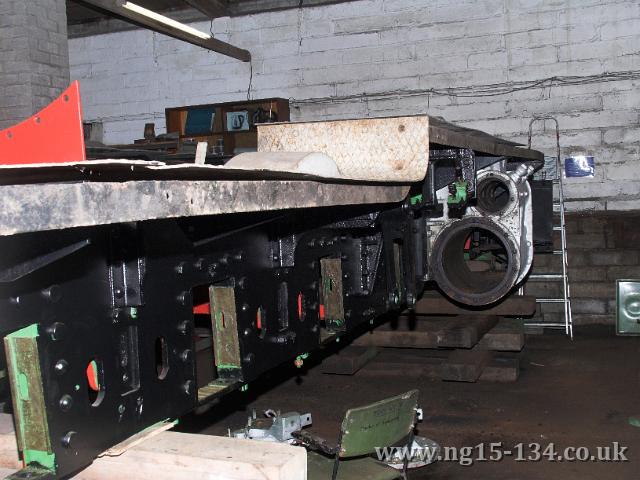 |
The side running plates
have been loosely fitted to enable pipe runs to be established.
Click the picture to go to
the Gallery page for more pictures
We also fitted the side running plates in order to be able to establish pipe runs for the new copper pipework. This is a temporary fitting as some of the components, especially the angled support edge strip, are to be replaced. Alongside this, work continued with the clearing out of the internal valve spaces in the cylinder casting. There is 40 or so years worth of deposits that have built up in the valve chests (never mind the numerous pieces of metal work removed from inside during an earlier working party) and this all needs cleaning out.
The last major job completed on the Saturday was the removal of the cab steps. These are actually on the tender and as this is being altered in order to make the Loco more suitable for use on the WHR they will be in a different position. In order to remove one step the handbrake shaft had to be be removed. There will be a need to remove the modifications made to the tender some 10 years ago when the restoration first started and when a different tender outline was envisaged.
Another interesting 'phenomena' of the weekend was in arriving to discover our boiler had moved! As part of the general tidy up of Dinas yard is seems 134's boiled has been moved to alongside the Clip Shed where the rest of the Loco is stored.
Sunday saw the continuation of the removal of worn bushes from the Loco's spring anchors and compensation beams. This was a job started on the Saturday. Also a continuation was the cleaning out of the cylinder casting's internal steam passages. This resulted in the discovery that left rear valve cylinder liner is in the wrong place by ½” and the right cylinder liner is in the wrong place by 3/16”! As the liners had already been turned the positional discrepancy cannot be rectified. There was also an original casting defect found deep inside in one of the steam passages – a large flash of metal restricted the steam flow. This was easily rectified by the use of a very long chisel.
Yet another discovery was when heating up the studs on the blast pipe flange ready for their removal. This combiner casting for the two cylinder exhausts does not possess a Kordina – a method of separating the two blasts before they reach the blast nozzle. To all intents it is an almost straight hollow casting between the two cylinders, tee’d up in the middle for the blastpipe connection. It would appear that there could be back pressures occurring that would be detrimental to the locos performance. This is an original design fault and will need careful thought as to how it might be possible to deflect each cylinder’s exhaust away from the other, without the cost of a modified, major casting. Hopefully with most of the discovered problems rectified better front end efficiency should be attained in the future.
February Team Wylfa work
Team Wylfa have continued plodding away on the Loco between the main Monthly working party weekends. This has mainly concentrated on the removal of the last few studs and cumulated in the removal of 6 more cylinder studs on the evening of 16th February by three of the team. This leaves one larger 3/4" BSW and two 1/2" BSW studs left to remove on the cylinder blocks themselves and four 'easy' ones on the mid frames blast pipe flange. This work should be completed as part of the main February working party due on the 20th & 21st. This should allow the final cleaning out of the internal steam passages etc to be done then the cylinders are ready to receive the refurbished pistons and valves at some time in the future.
Monthly Working Party - 23rd
& 24th Jan
2010.
A number of tasks were undertaken with this working weekend, not least the continuing saga of the removal of the studs from the cylinders!
One of the jobs needing to be done was the removal of the rear drag box and draw-bar as the former is very bent and the latter badly corroded to the point of being paper thin in places. A substantial amount of effort and thought went into this and in doing so it soon became apparent why the draw-bar is bent as bends in other platework showed up. At some time in its career the Loco has sustained a very heavy collision to the rear. By the end of Sunday the rear draw-bar had yielded (with the usual resort to the gas-axe on its pin) and was removed. The bent draw-bar will straighten, however the pin is scrap! The front South African coupling was also removed but this time without recourse to the melting machine!
Whilst this was going on, the horn guides were being tidied up and machined in the machine shop. With thanks again to our K1 friends for this task continued from last November.
So back to those damn studs. Team Wylfa had done some preparatory work on the removal of the sheared off studs in their previous evenings working party and this included the removal of some front platework studs as well. The job entails drilling out the centre of the stud, then collapsing it in on itself to allow it to be pulled straight out. Finally a tap is run through the thread to clean it ready to receive new studs.
The rear of the right hand
cylinder
with all studs removed.
Click the picture to go to the Gallery page for more pictures
The Tuesday following this working party weekend saw Team Wylfa remove more studs to the extent that only 8 are left to do and most of those have been drilled ready for collapsing.
The last job to mention was the painting of the wheelsets. The last two needing attention were steamed cleaned over the weekend with one receiving it red oxide primer (well 90% of it). This will be finished off at the next Team Wylfa evening, as will the last wheelset.
Other numerous jobs included the freeing of the valves from the manifold, removal of drain cock, with the refurbishment of both valves and drain cocks being a homework project, and finally the removal of the break beam. In the days following the working party the drain cocks were subsequently removed as a homework project by Matt and Dave Wilding. This showed that the inside of the valves were very clogged up with carbonised oil deposits and the valves themselves in very poor condition to the point of wanting renewing. The replacements will be made in stainless steel.
Picture showing the poor condition of the drain cock valve.
Mini New Year Working Party Jan
2010.
An extra none scheduled Working Party took place on the first weekend of January 2010. This was held to progress the welding of cracks in the frames and the removal of studs in the cylinders. The numbers on the working party were kept to a minimum, just three people, as there was to be quite a lot of welding and use of torches so the fumes were of concern in the confined area of the 'Clip Shed'. As it turned out the fumes were minimal.
The work concentrated on the welding of some cracks in the rear of the frames just above where the rear stretcher is riveted. A start was made on these although there's still some work left to complete this. The welds were then duly ground smooth.
With the torch being used in the shed the opportunity was taken to use it to help remove more of the stubborn cylinder studs. This involves heating the stud followed by a quick quench with water. This causes the corroded thread junction to fracture such that their removal is much easier. The rear of the right hand cylinder is now clear of studs, however there are still a few others still to remove at the next scheduled full working party or by team Wylfa at their next evening working party.
Some photographs are available on the Gallery page for the working party
Back to the Archive